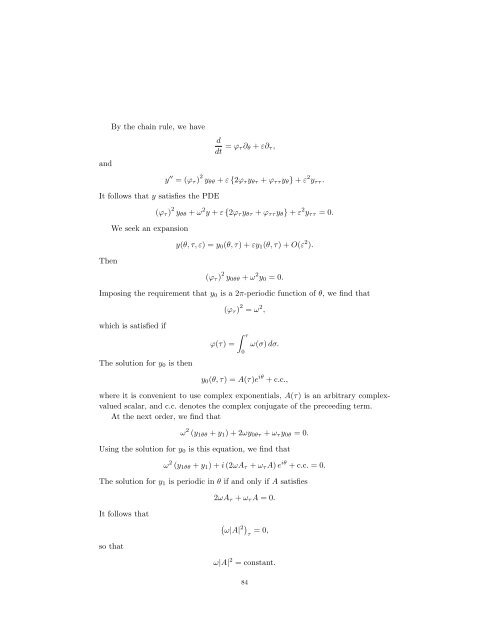Asymptotic Analysis and Singular Perturbation Theory
Asymptotic Analysis and Singular Perturbation Theory
Asymptotic Analysis and Singular Perturbation Theory
You also want an ePaper? Increase the reach of your titles
YUMPU automatically turns print PDFs into web optimized ePapers that Google loves.
<strong>and</strong><br />
By the chain rule, we have<br />
It follows that y satisfies the PDE<br />
Then<br />
We seek an expansion<br />
d<br />
dt = ϕτ ∂θ + ε∂τ ,<br />
y ′′ = (ϕτ ) 2 yθθ + ε {2ϕτ yθτ + ϕττ yθ} + ε 2 yττ .<br />
(ϕτ ) 2 yθθ + ω 2 y + ε {2ϕτ yθτ + ϕττ yθ} + ε 2 yττ = 0.<br />
y(θ, τ, ε) = y0(θ, τ) + εy1(θ, τ) + O(ε 2 ).<br />
(ϕτ ) 2 y0θθ + ω 2 y0 = 0.<br />
Imposing the requirement that y0 is a 2π-periodic function of θ, we find that<br />
which is satisfied if<br />
The solution for y0 is then<br />
ϕ(τ) =<br />
(ϕτ ) 2 = ω 2 ,<br />
τ<br />
0<br />
ω(σ) dσ.<br />
y0(θ, τ) = A(τ)e iθ + c.c.,<br />
where it is convenient to use complex exponentials, A(τ) is an arbitrary complexvalued<br />
scalar, <strong>and</strong> c.c. denotes the complex conjugate of the preceeding term.<br />
At the next order, we find that<br />
ω 2 (y1θθ + y1) + 2ωy0θτ + ωτ y0θ = 0.<br />
Using the solution for y0 is this equation, we find that<br />
ω 2 (y1θθ + y1) + i (2ωAτ + ωτ A) e iθ + c.c. = 0.<br />
The solution for y1 is periodic in θ if <strong>and</strong> only if A satisfies<br />
It follows that<br />
so that<br />
2ωAτ + ωτ A = 0.<br />
ω|A| 2 <br />
τ<br />
= 0,<br />
ω|A| 2 = constant.<br />
84
















